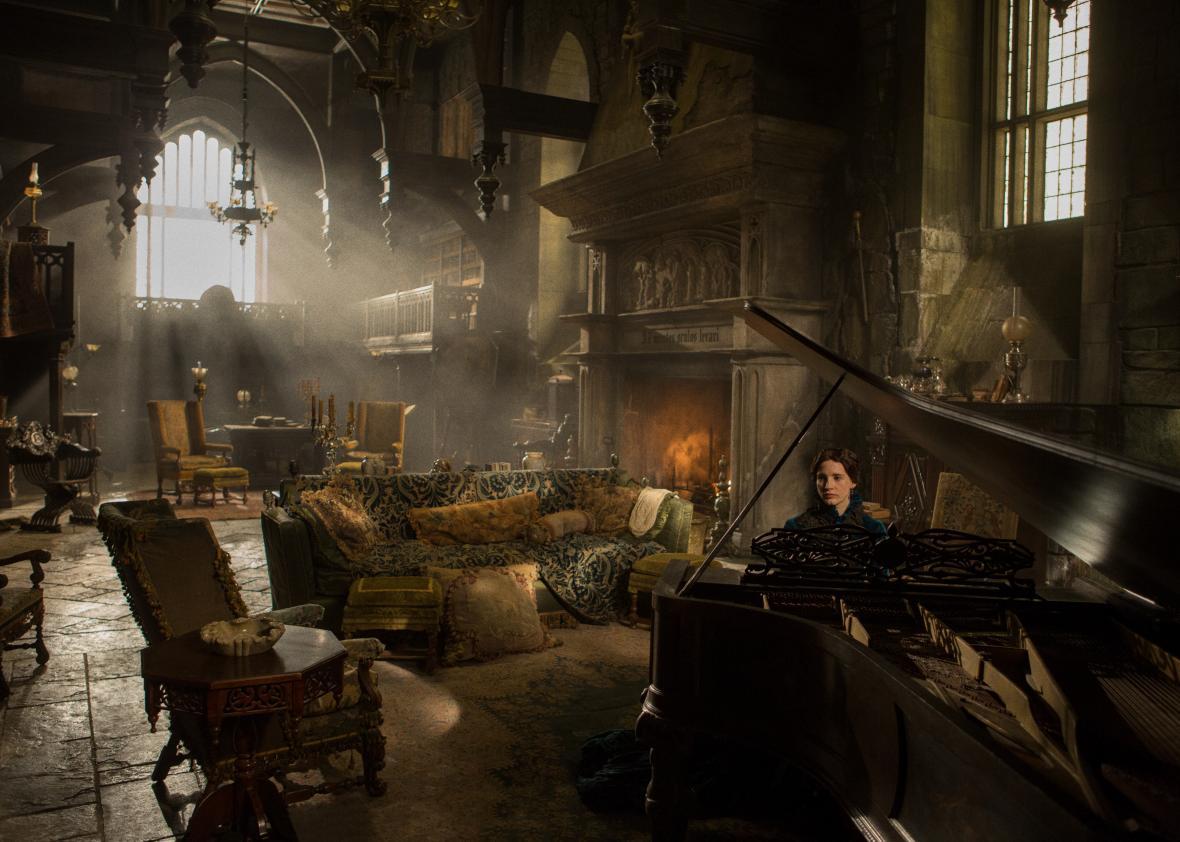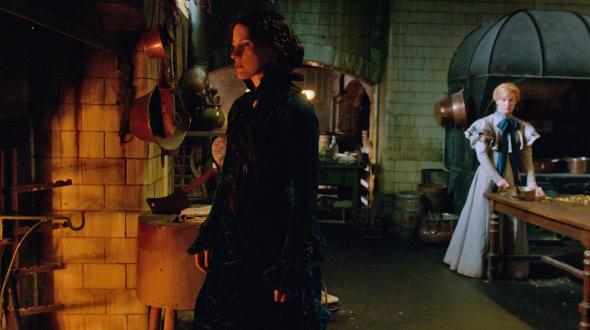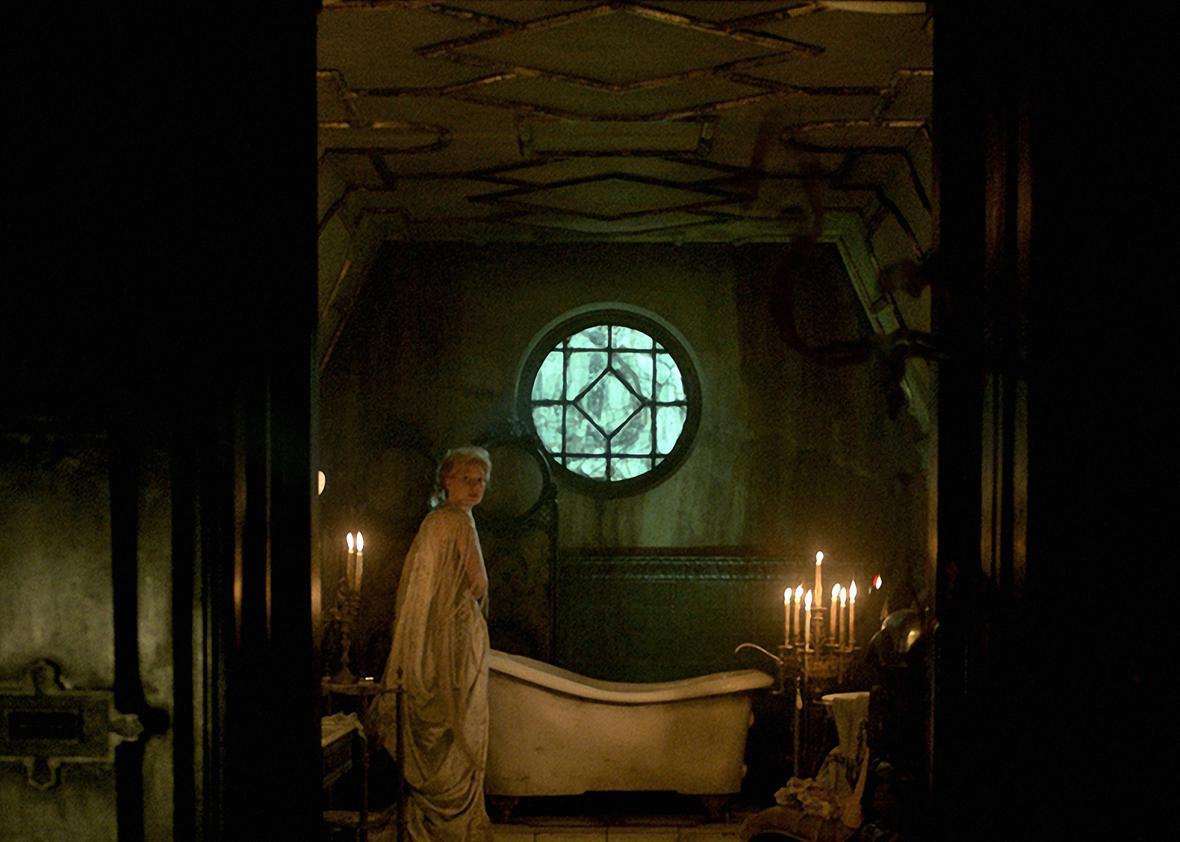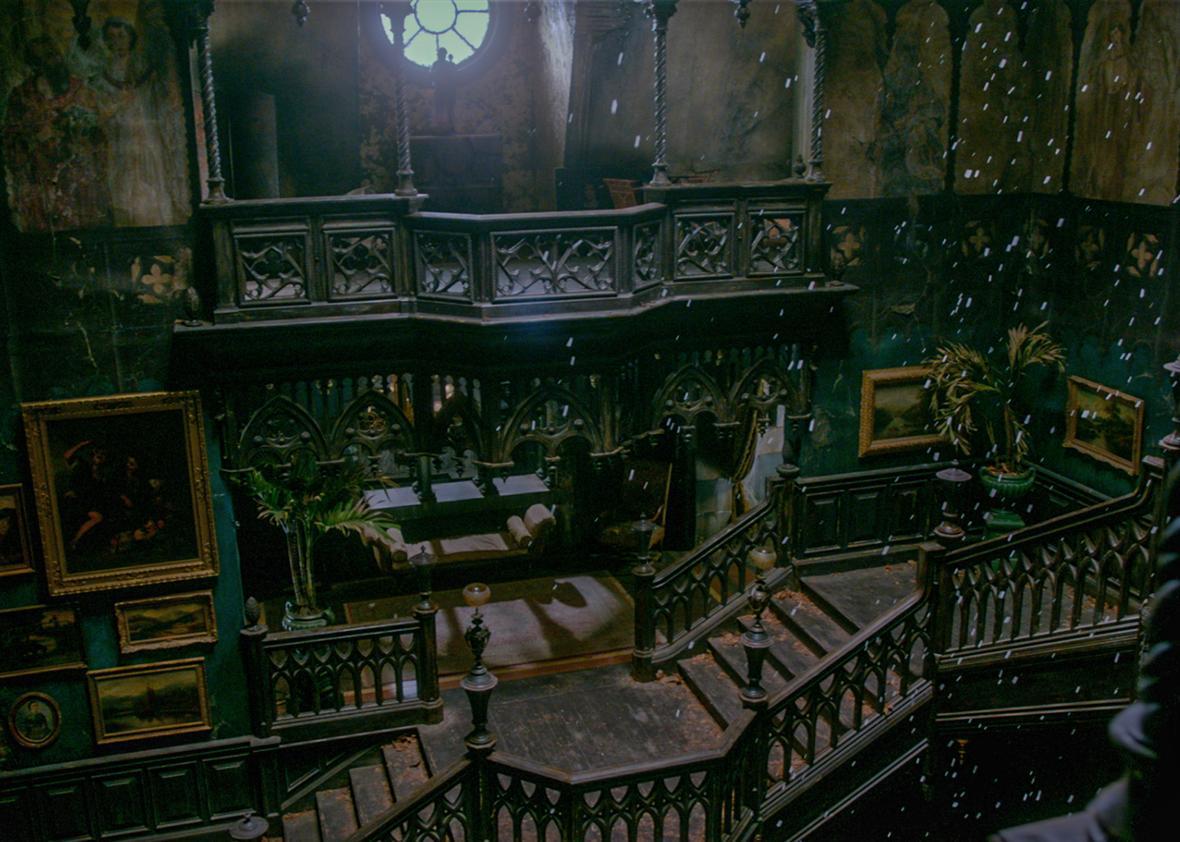While it may not have had enough narrative depth to satisfy some critics, there is one triumph of Crimson Peak that’s hard to deny: It’s a beautifully dark visual wonder, featuring what could easily become one of the most memorable haunted houses in movie history. This should be no surprise to anyone familiar with Guillermo del Toro’s singular imagination. And in this case, to help bring his vision for the film’s Gothic romance-inspired themes to life, he enlisted production designing vet Thomas E. Sanders (Braveheart, Apocalypto).
I spoke with Sanders about what it was like working with del Toro, designing that house, and how he made all the blood just the right shade of crimson.
I know Del Toro has cited some of the Old Hollywood movies that inspired him during the making of this film: Dragonwyck, Rebecca, Jane Eyre. What specific elements from those movies or others did you incorporate into the design of the movie, and the house in particular?
For the house, he likes [House by the Railroad, the Edward] Hopper painting, and that was the only thing that we went on for the house. I don’t do any film research when I’m working on a film, and I like to approach it really naive and work with the director and then just go for it and try to be fresh that way. So I didn’t watch a single film or refer to any film at all.

Legendary Pictures and Universal Pictures.
Did he throw out any of those movies to you when he was describing the movie or when you read the script?
No—you know by the time I had gotten involved, once we’d read the script, he didn’t do too much. A little bit now and then, but we didn’t really refer to much on an ongoing basis. I think for a few discussions he brought up a few films, but after that we just went for it, and he was busy on another project [The Strain].
How much of the house’s design came from your ideas, and how much was informed by his direction and staging?
Well it’s kind of both: at every level I would get to on the house I would bring him in and see how he felt about it, and luckily we were on the same page most of the time. And then we did a lengthy process—it was a couple months—where, on any sets like these I build physical models of the sets. And in that process we’re looking at all the camera angles and we’re looking at all the views through the house … and we edit as we go, we change it as we’re going, and it just slowly morphs into a complete finished model of the set as it is.

Legendary Pictures and Universal Pictures.
Each of the rooms has a distinct personality, between the kitchen, the basement, the bedroom, and so on. How did you decide what kind of moods you were going for in each of those rooms?
It’s kind of daunting doing a haunted house for a movie, and we were going to be in the house really a lot of shoot days, so I wanted every room [to] be completely different. So I had a different bent on it when we did the bedroom of the parents, just because the parents had lived in it, and that had a certain amount of layers. …We did [consider] the themes that were playing out in each room and what those rooms meant in the history of the house as well.
We felt that the clay is the blood of the earth, and it’s also the blood of the house, and that the house was a living thing that embodied the family over all those years.
The kitchen shows that there was once a huge staff, and it was very much a country kitchen from the neo gothic times … And then the great hall, which we felt was maybe part medieval and part they had redone it—all these houses were redone so many times through history, and that gave us a bunch of great layers to play with as well.

Legendary Pictures and Universal Pictures
The basement especially is visually striking. I don’t know how I would describe it exactly, but the giant circular design—
Yeah, it’s like a half-tunnel. I don’t know where that came from. I mean I did some early drawings of it and Guillermo really liked it, that it was an arched room.
You’re bringing back memories for me now of when we were designing it, you know. For me it’s such an organic process, and as a sculptor that’s why I do the models.
We got a pre-painted, pre-plastered model detailed of everything in the house before we even built the house. And it was a four-foot-high house and interior, and we could take walls out of the model, which we could take out on the set.

Legendary Pictures and Universal Pictures
Was the house constructed from scratch for the movie, or did you find a house that had the right atmosphere and create it out of that?
No … we knew we would never shoot in a real house. And in fact, there’s not a detail in the house that was real—it was taken out of the research in my head, and pretty much everything was invented for the set. And once we started building on it, [Del Toro] liked [Hopper’s] House by the Railroad, which was just like a two-story Tudor house that’s all lonely on this stretch of track—it had a great proportion. And then the other thing he wanted that was really important was that he wanted to feel the whole house when you walked in the front door, so the minute you walk in you’re in a big foyer and you can see all the way through to the great hall in the back and you can see all the way upstairs, so we wanted to establish this whole big house and the geography right off the bat.

Legendary Pictures and Universal Pictures.
One of the other things that was really fascinating to me was how perfectly red the blood was. I’m curious: how did you make the red goo crimson red?
Guillermo is… super, super color-oriented. We did a lot of color samples for him—and I’m very color oriented too—and it ended up [being that] a lot of them were based on corrosion and just weird things that really happen, and we really pounded that color until we felt that it was the perfect color for the movie.
And then also we have the issue of, you don’t want the set to outdo the costume, you want the costume to show up first… So when we had Edith in the house, we wanted her to be the butterfly in the house, but if you notice the other costumes, they almost match the house. You know they were in the same tones as the house, but we brought the tones back so their tones would be just a little bit brighter and a little bit better.
How did you get the snow to bleed red for that final scene?
Well some of it was underneath the snow already, because we laid down red earth, but for the last bit it was a CG takeover of the red. At the premiere the other night was the first time I’d seen it, and I was blown away at how it finished, because when we’re through working on it there’s still a lot of added painting that gets done with the movie and they really nailed it, it was really great to see.
You’ve been nominated twice for an Oscar, for Saving Private Ryan and Dracula, but you haven’t won yet. Is there any behind the scenes campaigning for technical awards in the same way that there is for acting and directing awards?
I’m sure there is, but I’m not aware of it. To me I feel, I mean I love what I do, and to us it means you’re recognized and your pay may go up or whatever, but there’s no active campaigning. I think the studios may do a little bit of it and push it, and you know they put ads out, but … I don’t have a publicist or anything. It’s just kind of for us, at least for me, it’s just kind of a Whatever, if that happens—great.
You’ve done a gothic haunted horror with this and with Dracula, and you’ve [just completed the upcoming] Star Trek sequel, which is futuristic. Is there any artistic mode that you’d love to work in that you haven’t yet?
That’s a good question. You know I’ve done Mayan, I’ve done war, I’ve done medieval. You know for me if I see something that has either never been done before, like Apocalypto, when I read that it was the first time a Mayan movie was going to be made. I still like to be really frightened when I start a movie, like, you know, How the fuck am I going to do that? And I think what keeps me really full of energy is fear. When you see something like that, like working with Guillermo—that was daunting! … And to do a haunted house for Guillermo, it’s like Wow, I better do good on this. So I have that energy—I’m 62, but I still have that energy, I love to start something that I haven’t done something like it before.
